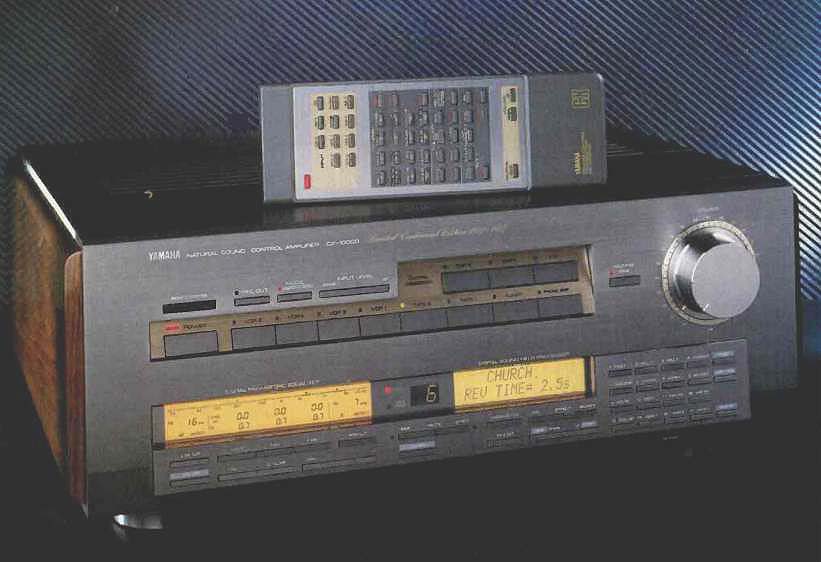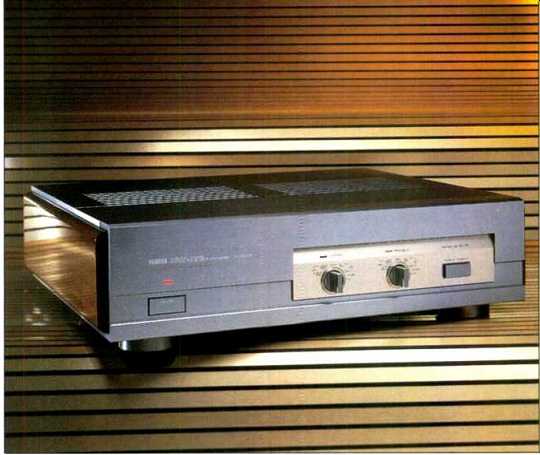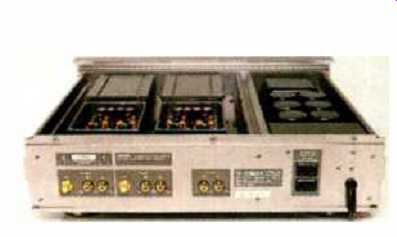
Company Address: 6600 Orangethorpe Ave., Buena Park, Cal. 90620, USA.
The Yamaha CX-10000 "natural sound digital control amplifier" is undoubtedly the most complex preamplifier I have ever encountered. It combines virtually every video and audio switching feature I can think of with a built-in, 18-bit D/A converter, six-channel digital sound processing including 16 different preset room and hall effects, and a highly sophisticated parametric equalizer. The only thing the CX-10000 lacks is a phono gain and equalization stage, and this is available in a matching phono equalizer unit, the Model HX-10000. You can get the CX-10000 for $7,500 and the HX10000 for another $2,500. If this initially seems expensive, read on. The units are cheap if you accept a standard of value based on dollar per feature.
The CX-10000 is techno-glitz with a vengeance. There are roughly 52 controls on the front and 57 input and output jacks on the back. (You try and come up with a precise count while holding a 53-pound preamp in your lap!) Included are an 8-bit microcomputer-necessary simply to help you operate a few of the features-two complex front-panel data displays, and a 52-button remote control.
At a bare minimum, you can spend several weeks just setting this unit up and learning to understand how all its different features allow you to change the sound of music or switch the signals from your video equipment. While the CX-10000 may then be less interesting than sex, it will unquestionably be a more interesting companion than a law partner, spiritual advisor, or new president.
This issue of Audio isn't large enough to fully describe all the features, and I don't get paid by the word.
Even a short list of what this unit can do, however, should whet the appetite of any serious audiophile. You get: A three-transformer power supply with separate power supplies for the digital, analog, and video sections; Double-sided glass-epoxy circuit boards; Solid dual-chassis construction with isolated digital and analog sections and with all amplifiers separately enclosed in aluminum units; Eleven audio and video inputs, which provide the ability to operate two VCRs, two videodisc players, two analog tape decks, two DAT recorders, a CD player, a phono amp, and a tuner.
Switching is accomplished by the aforementioned 8-bit digital microprocessor, and discrete transistor switching is used instead of contact switching; The ability to vary the sensitivity of each input by up to 6 dB; Electronic, rather than electromechanical, gain control; Digital parametric equalization with three separate bands, covering 61 central frequencies, adjustable by bandwidth (in 1/6-octave increments), by level, and by sharpness of slope (Qs of 0.7, 1.4, 3.0, and 6.0 are available); High and low variable-slope cutoff filters; Digital sound processing with 16 different acoustic mode settings, each of which can be varied by room size, and ranging from concert hall to rock concert and from church to warehouse loft. (I am a tad perplexed by the setting for warehouse loft. I've seen music abused in some strange places, but I can scarcely say I've found this one common enough to be immortalized on a front panel.) The user can vary the parameters in each setting to adjust them to personal taste, and can even create his own (may I suggest elevator, brothel, or closet?); A full 18-bit D/A converter to allow a direct input from a CD player or DAT recorder, four-times oversampling, and 16-bit conversion of the ambience information. There also are two digital record outputs with built-in dither capability; Outputs for two front and two rear presence (or ambience) channels.
This requires four additional channels of power amplification and four more speakers, although you can use only the two rear channels in a pinch; User naming of the input or program on the data display; Published specs of less than 0.003% harmonic distortion, 110 dB of S/N ratio, and a bandwidth of 15 Hz to 100 kHz.
If you add the HX-10000, you get another unit with two separate FET/ MOS-FET phono amplifiers, each of which can switch between moving magnet and moving-coil operation.

above: HX-10000
You can switch between 100- and 300pF capacitive loads for the moving-magnet input and 10-, 30-, and 100 ohm loads for the moving-coil input.
The moving-magnet setting has a sensitivity of 120 mV and an S/N ratio of 99 dB; the moving-coil setting has a selectable sensitivity of 3.4 or 12 mV and an S/N ratio of 94 dB. The HX-10000's rated harmonic distortion is less than 0.002% at any setting, and equalization is claimed to be accurate within ±0.2 dB. The moving magnet separation is 66 to 86 dB, and the moving-coil separation is 50 dB. Like the CX-10000, the HX-10000 is built better than the average battleship. It weighs 44 pounds, has four separate mechanically isolated circuit boards, and uses two-box chassis construction.
This list of features will be fascinating to most Audio readers but may be intimidating to a few. Let me assure you, then, that anyone who can read an instruction book can rapidly learn how to operate the key functions of this unit. Further, all of this preamp's features are eminently usable. The CX-10000 is particularly easy to operate if you are only using the unit as a two channel preamp. For proof, I asked my daughter to hook it up without the instruction book. This took a mild bribe (use of the car), but she got it right the first time. No one who ever hooked up a system is going to have trouble using this unit as an audio preamp.
The CX-10000's video features are straightforward, although operating them may require that you actually read the instruction book. I also found, as with some other units which are this complex, that I got noticeably better picture quality when I grounded all my video components and used an isolation device to filter the a.c. line. You may need the help of an expert technician in setting up a complex video system using this sort of filtering device.
Many cable installations lack the signal strength to prevent a loss of picture quality when the signal is passed through such a system. Ghosts, vertical bars, and noise are easy to create-even if one is only dubbing the video from unit to unit.
The video features are all useful, but the CX-10000 also has the same basic ergonomic problem as every other Japanese video switching device I've encountered. There are no separate circuits for the TV monitor tuner's video and audio outputs. However, given the number of inputs, this is minor, since most users can give up one videodisc input and still hook up a videodisc player and two VCRs.
The parametric equalizer and variable highand low-pass filters are slightly more difficult to use, but the instructions are straightforward and easy to understand. The CX-10000 is also capable of correcting most major room problems and some tonal balance problems in speakers.
This Yamaha preamp's equalizer section is far more useful than most stand-alone equalizers, which typically have 12 to 24 controls. Rather than trying to use a combination of fixed octave controls, the Yamaha allows you to attack the specific problems in your system. The bass control is particularly helpful in removing typical room resonance problems. However, it suffers from the fact that most problem installations will have several major peaks and valleys in bass response, and the CX-10000 can only correct the worst of these.
The sole difficulty in using the parametric equalizer lies in deciding which adjustment is right. The best results often come from a sharp, narrow-band bass cut to correct the worst peak in bass response, minimal adjustment of the midrange, and choosing a point in the upper midrange where you can adjust the overall balance of your system to what you feel is musically natural. Remember, even a 1-dB change can fine-tune many systems. If you have too much overall treble energy, use the high-pass filter and find the slope that sounds best. The fact is, very few audiophiles listen well enough to adjust such a control on their own, and no one can achieve a technically correct setting without a measurement device having at least 1/3-octave resolution.
My advice is: Get assistance from several good listeners, and don't try to create measured flat response in the upper octaves. With few exceptions, any system that measures flat in the listening position will have so much upper midrange and treble energy that it will sound unbearably bright. On the whole, if careful and slow experiment produces results which sound right to several good listeners, then you have it right.

Rear and interior view of HX-10000
The D/A converter features are not particularly complex and work quite well, but they are something of a mixed bag. The user should be aware that it is not possible to dub digitally from CD players to DAT units. As for the value of using the D/A converter in the CX10000, I would strongly suggest you experiment before you bypass the converter in your CD player or DAT deck. Regardless of the theoretical and technical merits of Yamaha's 18 bit, four-times oversampling system, it did not always produce for me the same sonic clarity, natural dynamics, or upper octave tonal balance as the regular D/A converter in a Sony DAT unit. It did improve the sound of NEC, Denon, and stock Philips CD players, but it degraded the sound from the Mod Squad and top-of-the-line Sony CD players auditioned with it.
By and large, I question the value of this converter because so many changes are taking place in this technology, it may quickly become obsolete. I also do not know of any CD or DAT units that do not come with D/A converters. Even Yamaha's CDX10000 CD player comes with its own 18-bit, four-times oversampling converter. Further, no one is really going to use a $7,500 preamp with an older or non-audiophile CD player.
For many, the CX-10000's digital sound-field processor will be its most attractive and useful feature. It's worth pointing out that much the same component, in separate form-the DSP-1sells for nearly $1,000. Among the major features in this Yamaha preamp, however, the sound-field processor is also unquestionably the most difficult to use properly.
You need four identical channels of amplification in addition to a normal stereo power amp. The CX-10000 also requires four identical full-range speakers, in addition to the two main speakers. Few things in high-end audio are more pathetic than a complex sound system using low-grade ambience speakers which do not match each other exactly and which do not match the main speakers. Ambience then comes at the direct expense of smearing and confusing the music.
This is particularly true in the case of the CX-10000. Getting the best results requires the use of high-frequency output to the ambience speakers, and even the low-frequency output goes up to 1 kHz and thus has a great deal of midrange data. Poorly matched speakers will be clearly audible.
Even an experienced audiophile is going to find this kind of system a bit ambitious, and hookup will be difficult.
You also need to make a prolonged effort to get all volume adjustments correct. Trying to simply use the default settings in the CX-10000 is an almost certain recipe for getting an unbalanced system and unrealistic hall effects. You can use the CX-10000 to adjust the volume to each of the four ambience speakers, but the process is laborious. I would like to be able to easily pan the gain for these four speakers as well as to adjust their overall levels, using the remote control. In many systems, adjustment may be needed for each recording to get the best results, and music with badly mixed artificial re verb can be a bit of a trial.
In most cases, the ambience speakers will have to be mounted on stands taller than a standing man or in the upper corners of the room. Further, the room will require careful treatment to minimize reflection. Odd-shaped rooms, or those with one or two open ends, may require special treatment.
The instruction book only hints at the amount of speaker setup adjustment that may be required to get the best out of the digital sound-field processor, and an experienced technician may be required to get the best results.
Finally, I do not recommend the use of the sound-field processor with bipolar speakers in anything but the largest home listening rooms, non-bipolar main speakers with exceptionally narrow listening areas, or only the front or rear ambience speakers. The use of bipolar speakers and the ambience speakers can result in a bloated soundstage that is more than a little overdramatic. The use of the ambience speakers with two main speakers that have a narrow listening area can produce odd shifts in the soundstage with minor shifts in head position, and the use of only a pair of ambience loudspeakers yields sharply inferior results to the use of four.
Because the setup is difficult, it may mean the creation of a dedicated listening room. Nevertheless, the end result may well be worth it. Every audio dealer and club should have one such installation to show what modern signal processing can do. I might argue about some of the labels selected by Yamaha to describe different types of listening areas, and I would caution that the digital sound-field processor cannot reproduce the directional data on Dolby-processed films with the utmost degree of realism. Still, it is generally possible to find a remarkably convincing hall effect for virtually any music or video material, and the results are sufficiently impressive to overcome prior conditioning against such devices in the most dedicated purist.
While you cannot really re-create the concert hall in your home, you can come close to the ambience of live music. As a classical music buff, I preferred "Hall 1," " Munster," and "Chamber," but the less enlightened members of my family loved the modes for rock concert and "Stadium." Our garbage man, who has upgraded his career from lowly beginnings as an investment banker, preferred "Disco." More seriously. if audio is supposed to mix realism with sheer fun, the sound-field processor does what it is supposed to do. Unlike four-channel sound and reverberation devices, the effect does not get boring or irritating with prolonged exposure. The processor can also correct for many types of recording abuses and can salvage many great performances which lacked equally great recording techniques. If it produces some occasional sonic oddities, only a Grinch could really complain-provided the system is properly set up in the first place.
If it sounds like I would enjoy owning the CX-10000, well, I would. I think anyone who prefers getting the emotional impact of sound over ultimate transparency will be happy with this unit. It will also be of interest to musicologists and to those interested in the effects of different hall and listening room conditions. This preamp allows a tremendous amount of processing of any given performance, and it can correct for a very wide range of faults in the source material without inflicting the sonic suffering which is common in most signal processors.
Even judged without its special features, the CX-10000 is a good preamp.
It has good frequency extension in the treble and bass, excellent S/N performance, good dynamics, and a pleasant overall tonal balance without upper midrange hardness or veiling. Overall transparency is good, and the sound stage is adequate in terms of depth, width, and placement of instruments--even without the ambience speakers.
Let me also say, however, that you do pay for all these features in terms of ability to provide the transparency, dynamics, and life found in the best high end preamps, including some that cost considerably less than $1,000. The CX-10000 slightly blurs and softens the sound, adding a touch of dullness to musical transients and removing some fine detail. This is particularly true when you add the phono stages in the HX10000 to the preamp. The HX-10000 is smooth and silent, but it also has more than a slight touch of grain. Further, I suspect that many American audiophiles would prefer a high-impedance loading for moving-coil cartridges, not simply 10, 30, and 100 ohms.
The real issue in judging the CX10000, therefore, is whether you desire its special features. It is not the ultimate preamp for an audio purist, in terms of sheer transparency and life, but few people live in homes or own audio systems that will not benefit from the parametric equalizer. Further, the fortunate few who can really afford a proper digital sound-field setup and this probably includes anyone who can pay up to $10,000 for a CX-10000 with the HX-10000 may well find that the processor is worth some minor sonic trade-offs. To quote one of the century's more obscure occidental philosophers, "The issue is whether more is less, or more is more."
-Anthony H. Cordesman
(Source: Audio magazine, Jan. 1989)
Yamaha Model B1 Power Amplifier (Aug. 1975)
Yamaha M-70 Power Amplifier (Jan. 1984)
= = = =